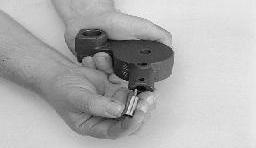
4 minute read
General Service Practices and Part Inspection
Inspection
Before assembling the transmission, check each part carefully for abnormal or excessive wear and damage to determine reuse or replacement. When replacement is necessary, use only genuine Eaton® Fuller® Transmission parts to assure continued performance and extended life from your unit.
Since the cost of a new part is generally a small fraction of the total cost of downtime and labor, avoid reusing a questionable part which could lead to additional repairs and expense soon after assembly. To aid in determining the reuse or replacement of any transmission part, consideration should also be given to the unit’s history, mileage, application, etc.
Recommended inspection procedures are provided in the following checklist.
Bearings
1. Wash all bearings in clean solvent. Check balls, rollers, and raceways for pitting, discoloration, and spalled areas. Replace bearings that are pitted, discolored, spalled, or damaged during disassembly. 2. Lubricate bearings that are not pitted, discolored, or spalled and check for axial and radial clearances. 3. Replace bearings with excessive clearances. 4. Check bearing fit. Bearing inner races should be tight to shaft; outer races slightly tight to slightly loose in case bore. If bearing spins freely in bore, case should be replaced.
Bearing Covers
1. Check covers for wear from thrust of adjacent bearing. Replace covers damaged from thrust of bearing outer race. 2. Check cover bores for wear. Replace those worn or oversized.
Clutch Release Parts
1. Check clutch release parts. Replace yokes worn at cam surfaces and bearing carrier worn at contact pads. 2. Check pedal shafts. Replace those worn at bushing surfaces.
Gears
1. Check gear teeth for frosting and pitting. Frosting of gear teeth faces presents no threat of transmission failure. Often in continued operation of the unit, frosted gears “heal” and do not progress to the pitting stage. In most cases, gears with light to moderate pitted teeth have considerable gear life remaining and can be reused, but gears in the advanced stage of pitting should be replaced. 2. Check for gears with clutching teeth abnormally worn, tapered, or reduced in length from clashing during shifting. Replace gears found in any of these conditions. 3. Check axial clearance of gears.
Gear Shift Lever Housing Assembly
1. Check spring tension on shift lever. Replace tension spring if lever moves too freely. 2. If housing is disassembled, check gear shift lever bottom end and shift finger assembly for wear. Replace both gears if excessively worn.
Gray Iron Parts
1. Check all gray iron parts for cracks and breaks. Replace parts found to be damaged.
Oil Return Threads and Seals
1. Check oil return threads on the input shaft. If return action of threads has been destroyed, replace the input shaft. 2. Check oil seal in rear bearing cover. If sealing action of lip has been destroyed, replace seal.
O-Rings
1. Check all O-rings for cracks or distortion. Replace if worn.
Reverse Idler Gear Assemblies
1. Check for excessive wear from action of roller bearings.
Shift Bar Housing Assembly
1. Check for wear on shift yokes and blocks at pads and lever slot. Replace excessively worn parts. 2. Check yokes for correct alignment. Replace sprung yokes. 3. Check lockscrews in yoke and blocks. Tighten and rewire those found loose. 4. If housing has been disassembled, check neutral notches of shift bars for wear from interlock balls.
Sliding Clutches
1. Check all shift yokes and yoke slots in sliding clutches for extreme wear or discoloration from heat. 2. Check engaging teeth of sliding clutches for partial engagement pattern.
Splines
1. Check splines on all shafts for abnormal wear. If sliding clutch gears, companion flange, or clutch hub has worn marks in the spline sides, replace the specific shaft affected.
Synchronizer Assembly
1. Check synchronizer for burrs, uneven and excessive wear at contact surface, and metal particles. 2. Check blocker pins for excessive wear or looseness. 3. Check synchronizer contact surfaces on the synchronizer cups for wear.
Washers
1. Check surfaces of all washers. Washer scored or reduced in thickness should be replaced.
Assembly
Make sure that case interiors and housings are clean. It is important that dirt and other foreign materials are kept out of the transmission during assembly. Dirt is an abrasive and can damage polished surfaces of bearings and washers. Use certain precautions, as listed below, during assemble.
Axial Clearances
Maintain original axial clearances of .006" to .015" for mainshaft gears.
Bearings
Use a flange-end bearing driver for bearing installation. These special drivers apply equal force to both bearing races, preventing damage to balls/rollers and races while maintaining correct bearing alignment with bore and shaft. Avoid using a tubular or sleevetype driver, whenever possible, as force is applied to only one of the bearing races.
Capscrews
To prevent oil leakage and loosening, use Eaton/Fuller sealant #71205 on all capscrews.
Gaskets
Use new gaskets throughout the transmission as it is being rebuilt. Make sure all gaskets are installed. An omission of any gasket can result in oil leakage or misalignment of bearing covers.
Initial Lubrication
Coat all limit washers and shaft splines with Lubriplate during assembly to prevent scoring and galling of such parts.
O-Rings
Lubricate all O-rings with silicon lubricant.
Universal Joint Companion Flange or Yoke
Pull the companion flange or yoke tightly into place with the output shaft nut, using 450-500 Lbf-ft of torque. Make sure the speedometer drive gear or a replacement spacer of the same width has been installed. Failure to pull the companion flange or yoke tightly into place can result in damage to the mainshaft rear bearing.
IMPORTANT: See the appropriate Illustrated Parts Lists (specified by model series) to ensure that proper parts are used during assemble of the transmission.










